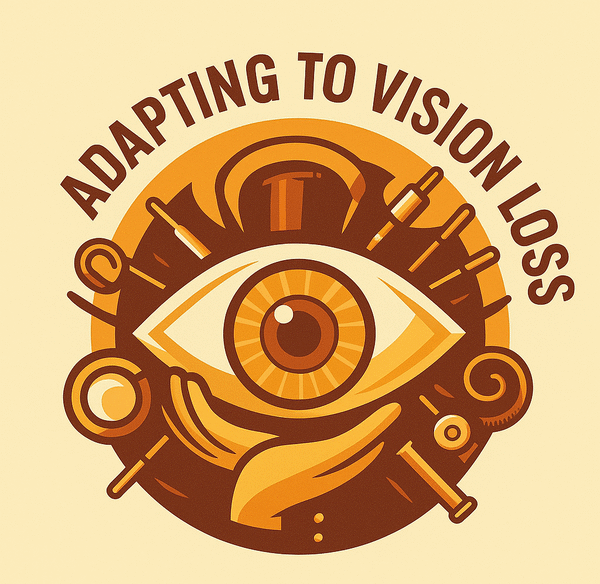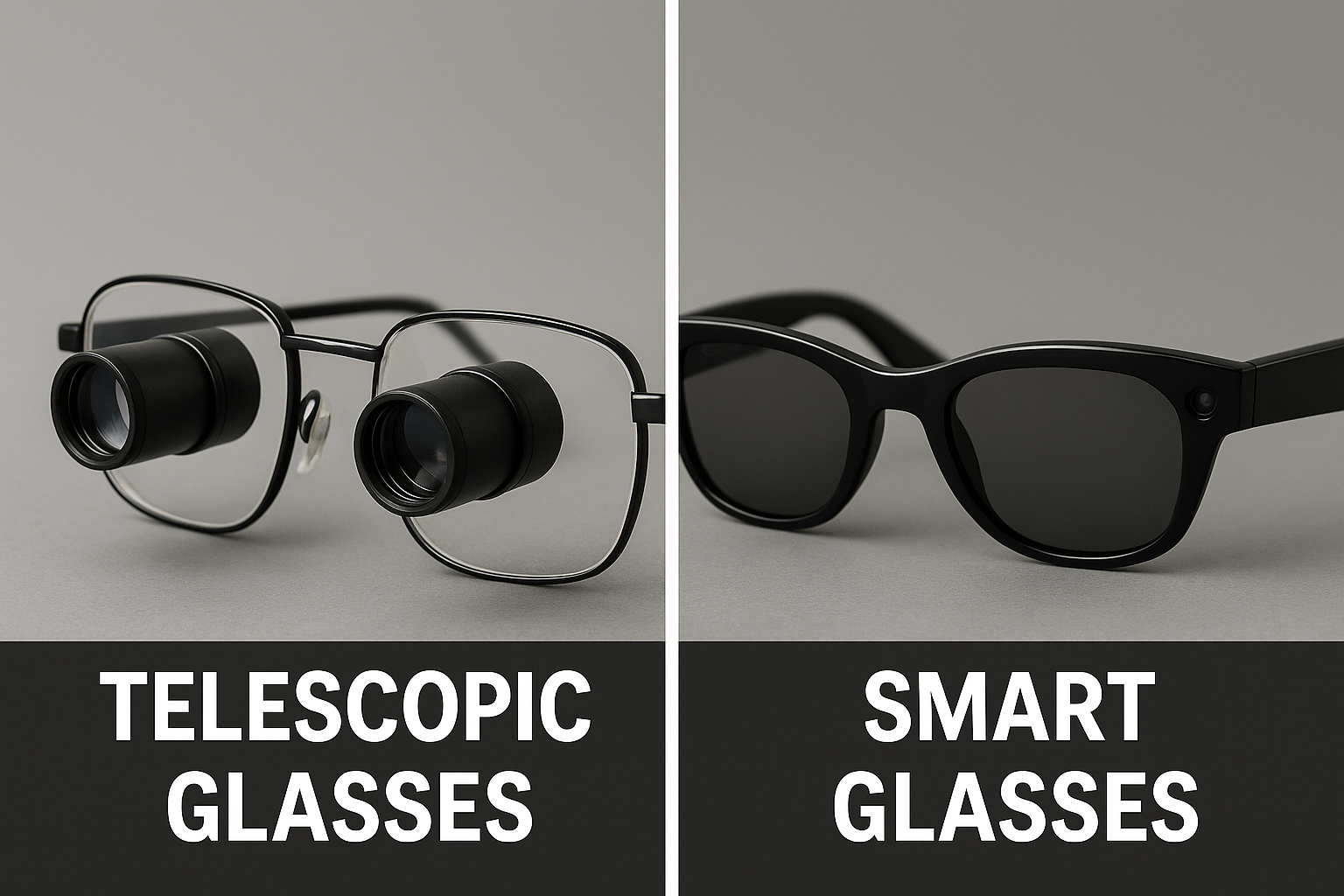Understanding The Real Differences For Low-Vision Users
When I first started comparing telescopic glasses vs smart glasses, I quickly realized they serve completely different purposes for people with low vision. Telescopic glasses and smart glasses both promise new ways to help us stay independent, but from my own experience, they offer very different tools for day-to-day life. I use each type for specific situations, and in this guide I want to share what makes them unique, especially if you’re navigating vision loss and trying to decide which option fits your lifestyle.
Telescopic glasses have been around for ages, often used by people with significant central vision loss to magnify distant objects. Smart glasses, driven by recent tech trends, are usually designed for features like handsfree photography, voice assistants, and discrete audio; not direct magnification or vision help.
If you, like me, are deciding which fits your lifestyle and vision needs, here’s how they stack up.
🔍 Quick Introduction to Each Option
🕶️ What Are Telescopic Glasses?
Telescopic glasses use miniaturized telescopes attached to ordinary eyeglass frames. These tiny lenses provide magnification that helps me see distant objects more clearly. For example, when I’m at a sporting event or trying to read a street sign from across the road, telescopic glasses can bring those details into focus. They were first made for people with severe vision problems, especially those with macular degeneration, and offer a practical way to watch television, view presentations, or even just enjoy peoplewatching in public spaces.
 Telescopic glasses with built-in optical magnifiers designed to help people with low vision see distant details more clearly.
Telescopic glasses with built-in optical magnifiers designed to help people with low vision see distant details more clearly.
🤖 What Are Smart Glasses?
Smart glasses, like the Meta Ray-Ban or Bose Frames, borrow the look of regular glasses but pack in technology features instead of magnification. These usually include a camera (for photos and videos), speakers, microphones, and sometimes integration with virtual assistants. The big draw for me is the ability to take calls, get voice directions, or send messages handsfree. Some models also offer captioning or reading features, though they don’t actually help me see things more clearly if I have vision loss. Their focus is on tech-first convenience, not medical grade visual help.
 Smart glasses designed to look like everyday eyewear, with built-in speakers and a discreet camera for hands-free tech access.
Smart glasses designed to look like everyday eyewear, with built-in speakers and a discreet camera for hands-free tech access.
⚖️ Feature-by-Feature Comparison
Purpose and Intended User
Telescopic glasses are built for low vision users. Their single purpose is to increase the size or clarity of distant images, which is really helpful for people like me with conditions like macular degeneration or Stargardt disease. They’re not for people who want the latest gadget; they’re for those who need real visual help.
Smart glasses are made for mainstream tech users. I see them marketed more for handsfree tech access, with only a few features that could benefit low vision people, like audio feedback or AI assistance. They don’t make things look bigger or clearer through the lens.
Visual Boost
Telescopic glasses give real, optical magnification. That means my actual vision of the world changes. Faraway signs get bigger and details stand out. Most use a 2x magnification, but some go higher. The image may narrow (meaning a smaller field of view), but for target tasks like watching TV or viewing sports, this is very useful.
Smart glasses don’t magnify anything visually. If my vision is blurry or I can’t see faroff details, these won’t change what I see through the lenses. If the model allows, they can hold prescription lenses for standard correction, but not for serious low vision.
Technology and Features
Telescopic glasses are analog. The real magic is in the lens design, not electronics. Some rare, higher end eglasses (like eSight) use cameradriven digital magnification, which combines elements of both worlds, but these are different from typical telescope glasses.
Smart glasses win in features. I get voice assistants, GPS, phone calls, music, reminders, realtime photo and video capture, and sometimes even onthefly language translation. Still, none of these features affect how clearly I see objects directly.
Design and Ease of Wear
Telescopic glasses don’t blend in easily. The minitelescopes are visible on the frames, sometimes above, sometimes embedded. They’re bulkier than standard glasses, and can look a bit medical. In my experience, comfort depends on the quality and fit.
Smart glasses look and feel more like fashion eyewear. They blend in with regular styles, and since they don’t do any optical work, they’re just as light or lighter than ordinary glasses. I feel more comfortable wearing them around town or to social events.
Wearability and Everyday Use
Telescopic glasses are best for specific moments, not allday use. I wear them when I need them: at a ballgame, at church to see the altar, or for tasks like classroom learning. Eye fatigue can set in if I try to use them nonstop, since the field of view is much narrower than regular glasses.
Smart glasses work well for allday wear. I use them for music, directions, or even posting to social media with voice commands. I don’t get eye fatigue since they don’t change how I see; they just add audio and recording features. The experience is like wearing ordinary sunglasses, but with more capabilities behind the scenes.
 Using telescopic glasses to clearly view a television across the room — a helpful tool for distance tasks when living with low vision.
Using telescopic glasses to clearly view a television across the room — a helpful tool for distance tasks when living with low vision.
💡 Who Should Use Which?
Pick telescopic glasses if you need handsfree, optical magnification to see distance details due to low vision. Tasks like watching TV, following classroom presentations, or exploring nature trails all get much easier.
Pick smart glasses if you want handsfree access to your phone, music, or AI voice responses, and don’t need actual magnification. If your main interest is convenience and style, not visual correction, this is a better match.
🔄 Most Common Use Cases
- Telescopic Glasses: Watching TV, movies, or lectures; sporting events; spotting street signs; birdwatching.
- Smart Glasses: Recording daily life handsfree; calling and texting with voice; getting audio navigation; asking AI questions; discreetly listening to music or podcasts.
💸 What About Cost?
- Telescopic glasses range from around $175 for basic optical models (like Eschenbach MaxTV) up to several thousand for advanced digital systems. Insurance sometimes covers them if prescribed by a low vision specialist.
- Smart glasses go from about $250 to $400. They’re rarely covered by insurance, since they’re considered consumer tech, not medical devices.
🧑💻 The Competition: Other Smart Glasses and Advanced Options
- Bose Frames offer opnear audio but no camera or magnification.
- Vuzix and Envision Glasses add AI features like text reading for the blind or visually impaired, though magnification is still missing.
There are also advanced digital wearable visual aids (like eSight and IrisVision) that combine cameras, displays, and magnification, but these are much more expensive and specialized. Regular telescopic glasses and smart glasses don’t cross into this territory.
❓ Frequently Asked Questions
What practical uses do smart glasses offer for someone visually impaired?
Most smart glasses, like the Meta RayBan, are great for staying connected, capturing moments handsfree, getting directions, or listening to music discretely. If you rely on audio prompts, voice notes, or reminders, smart glasses can help. But they don’t magnify or boost low vision directly.
Can I use telescopic glasses for reading or driving?
Basic telescopic glasses usually aren’t good for closeup reading; their depth of focus often makes them blurry with nearby print. Reading glasses or electronic magnifiers work better here. Driving with telescopic glasses is tricky; they can be legally prescribed for bioptic driving in some states, but you must be trained and meet local rules. Always check in with a low vision specialist.
Are there smart glasses that also step up vision?
A few digital wearable aids like eSight or OrCam replace the standard lens with a camera and screen. They provide both magnification and digital boosts for some visual conditions, but these aren’t mainstream smart glasses; they’re medical devices and can be quite costly.
If you’re new to vision-support eyewear or just want more background before diving into the pros and cons, here are two excellent resources I personally trust:
American Aademy of Opthmology: Low vision Aids
American Foundation for the Blind: low-vision optical devices
My own advice: talk to your vision doctor about your main goals, and try both types if you can. What works for one person might not suit the next. Over time, you might even stumble upon a combination that steps up your daily life best.

